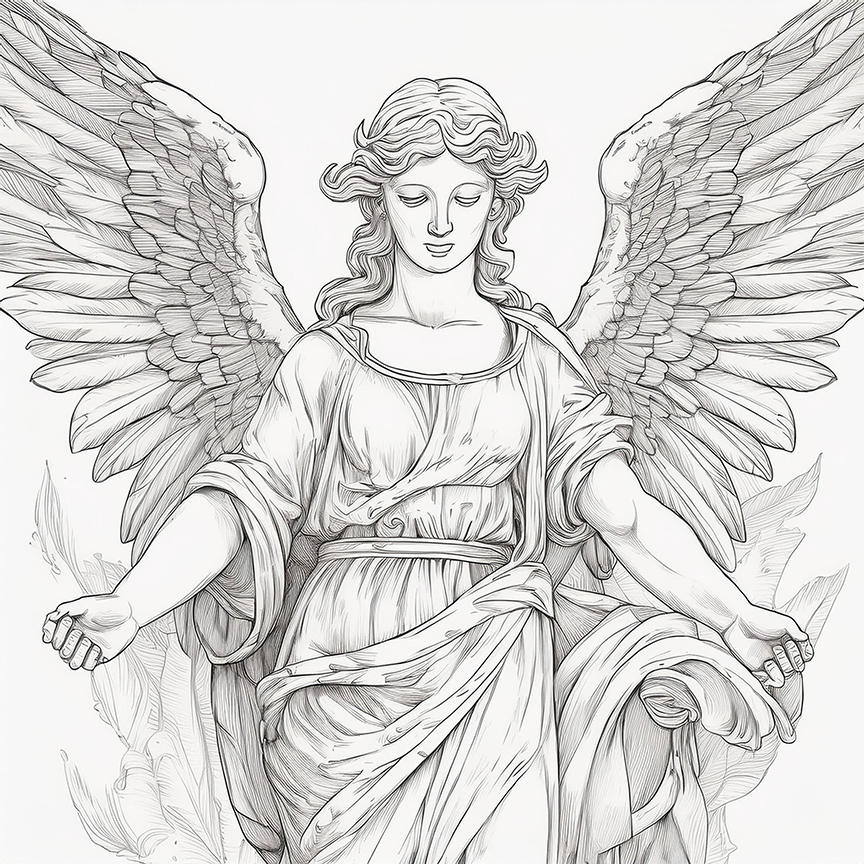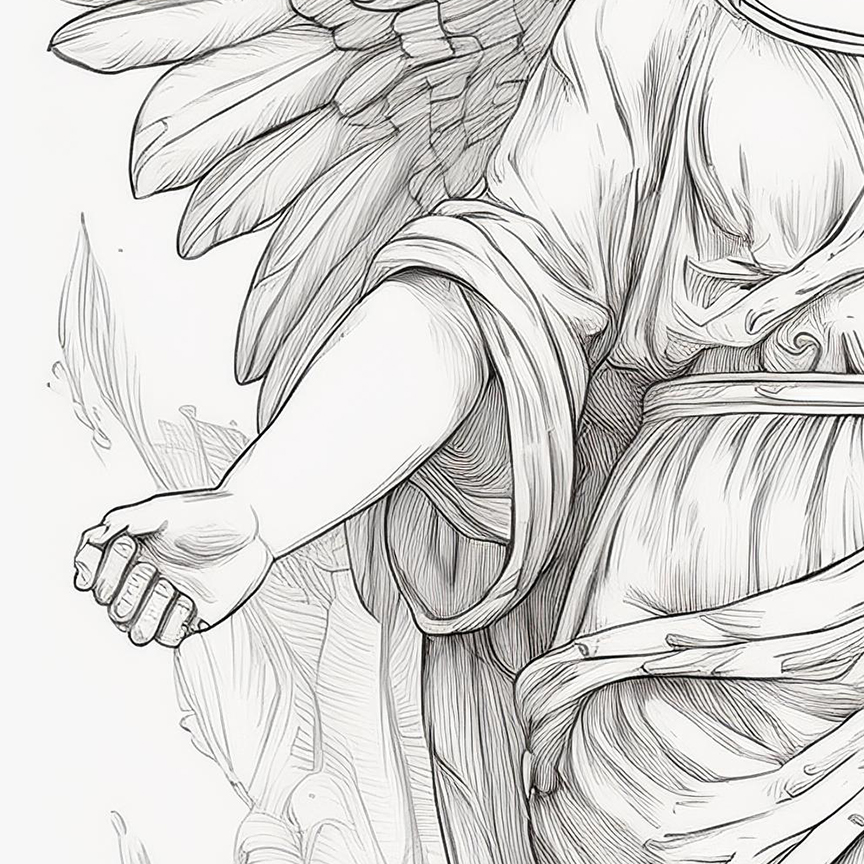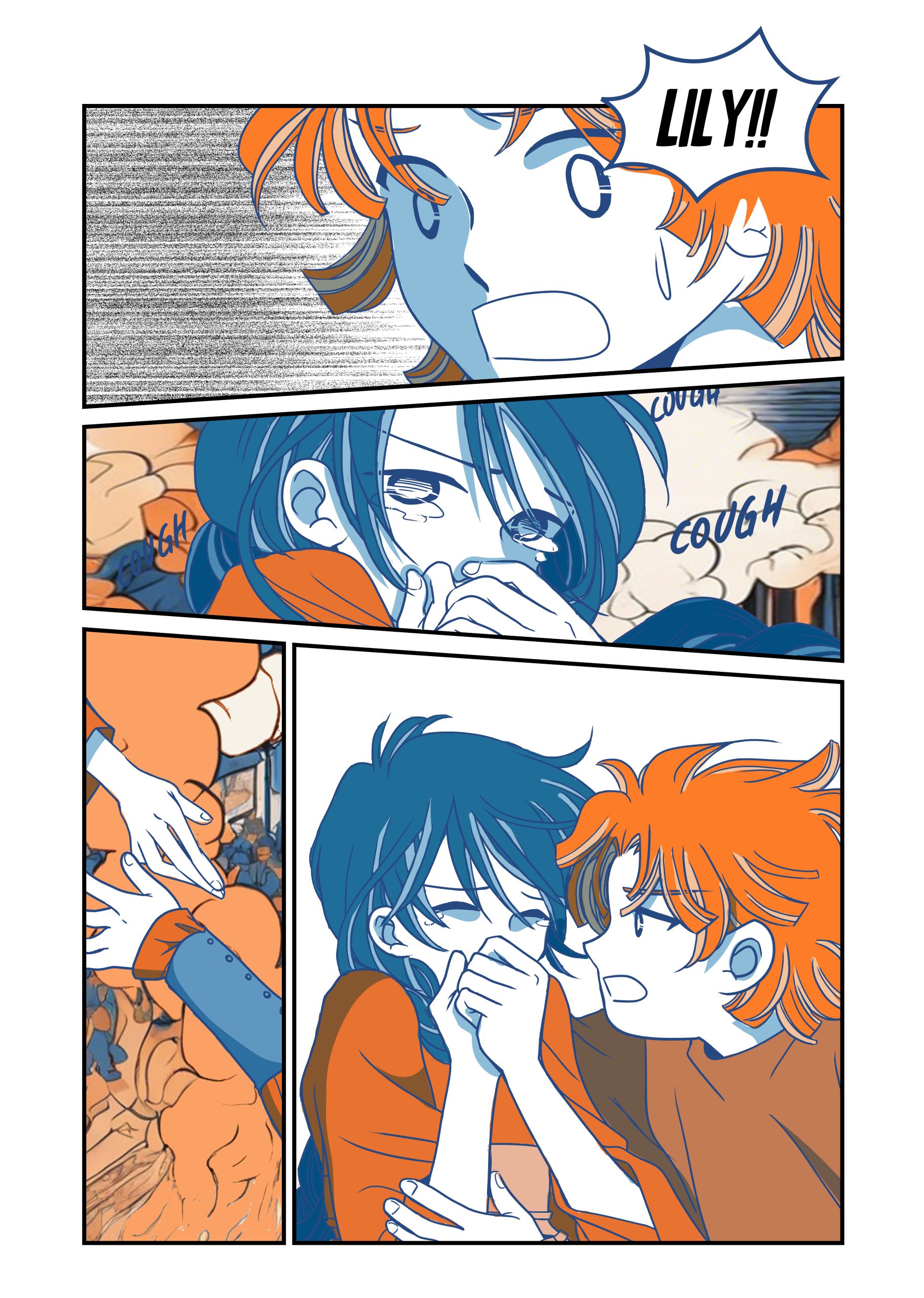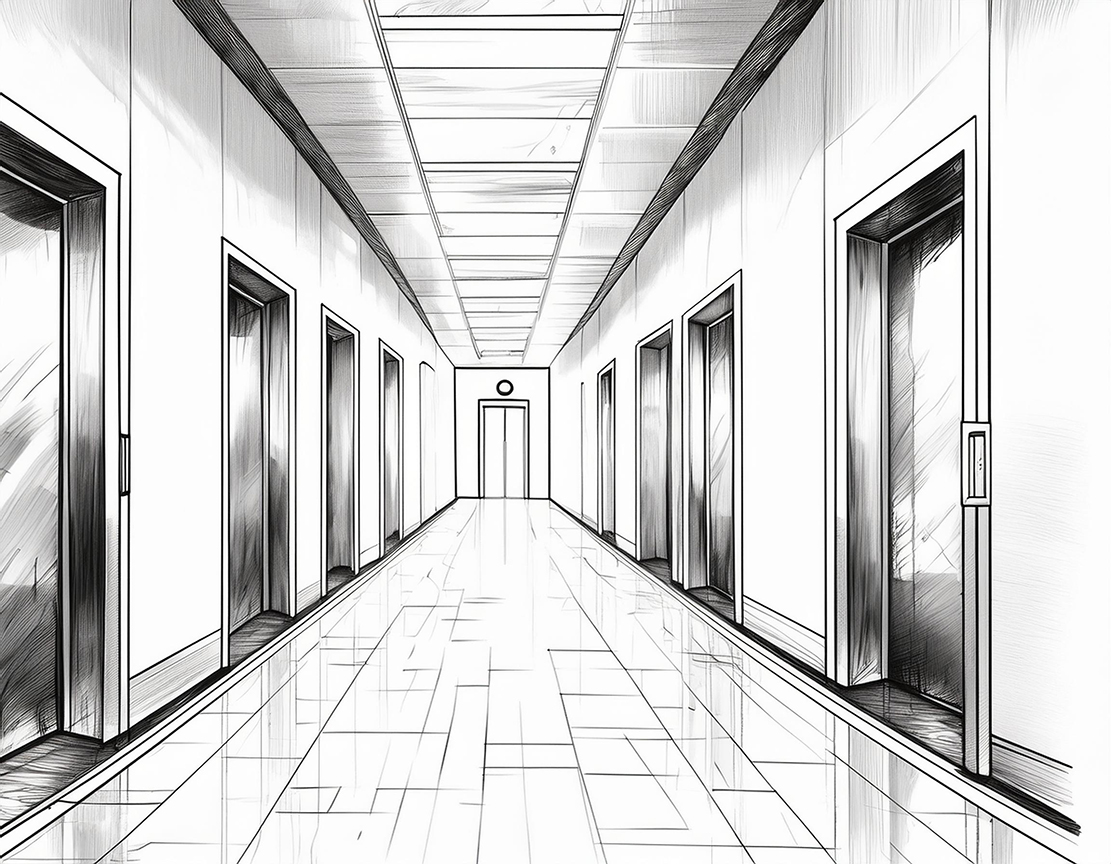College of Fine Arts
23 Exploring AI Image Generation as a Collaboration Tool for Comic Artists
Sarah Benedict and Lien Fan Shen
Faculty Mentor: Lien Fan Shen (Art & Art History, University of Utah)
Introduction
Art and humanity are synonymous; everything artists create is the result of their unique sets of experiences. Even when art making is used as a form of escape, life finds a way to bleed into every brushstroke. A lavish, rich, fictional world necessary for a comic series cannot be simply generated. The outputs from AI image generators ambushing the internet are messy and unorganized. Lines that are implying a mountain-scape spill into the sky. Strokes start and end unpredictably. People grow extra fingers, if not entire limbs. There is an obvious dissonance between the highly detailed, shaded style, and the confusing and out-of-place components that infect each output from these tools. Despite this, the role AI might eventually play is still uncertain. Professional artists must be able to continue to compete with the speed of AI image generators, or even integrate them into their practices. Despite the current, inconsistent quality of their outputs, AI art is undeniably prevalent and will continue to exist in the art world.


Methods
The objective of this project is to understand what role AI could have in the comic-making process from an artist’s perspective. Through the production of a limited comic series, Sand Sage, which uses different forms of AI generation tools at every stage, we explore how AI might eventually empower and collaborate with artists. AI was primarily utilized in the pre-production stages, including story development, character design, concept art, and layout design. In the finalized pages, several backgrounds are AI-generated while character drawings, page composition, and text placements are done using conventional methods.
Sand Sage follows two girls, Lily and Eliza, who live in a society that is trapped beneath a dome. The world outside is polluted to the point that humans must wear a mask to breathe, something which Eliza presents in the opening pages. The dome’s air is filtered using sand sage, which is a plant that can only be found outside. Both characters struggle in their environments, with Lily being unable to fulfill the expectations of her parents and Eliza being haunted by the past and the declining physical state of those who live within the dome. In using ChatGPT, we were given the chance to focus our efforts on areas of the plot we were interested in writing, while still implementing a complex world and cast. It provoked central plot points for Sand Sage and could generate a plethora of ideas that we could simply choose from. As we approached the last chapters of the series, we ran into a roadblock in finding a suitable ending. We used ChatGPT here as well, helping us understand what options we had left using prompts such as, “Help me find an end to this story”. This was a point when we reminded ourselves what elements of the story were most important to us. Because ChatGPT’s options were mainly focused on objective solutions to the storyline and conflicts within the dome, we realized that we wanted to integrate an emphasis on Lily and Eliza’s relationship and further develop the complexity of a side character. At multiple points of the project, we found that ChatGPT could be implemented seamlessly.

In the production phase of Sand Sage, we developed a method to include AI-generated images within the actual comic. The pipeline involved hand drawing the storyboards and line art, and then generating AI backgrounds to fill out each scene. Using AI images came with multiple issues, such as inconsistencies between the style of the character art and the backgrounds, struggles to generate certain prompts, and only being able to produce low-quality AI images. One background involved a hallway with an elevator at the end. I found that Adobe Firefly struggled to generate only one elevator, instead producing works with multiple elevators throughout the hallway. Some abnormalities can be remedied by collaging successful elements together. For the elevator scene, one solution may be to generate an elevator and an empty hallway separately, and then combine both elements using Adobe Photoshop. After backgrounds are generated, we would then color and shade the characters, implement textboxes, and apply final effects and details. With this method, we could consider the AI image generators as another artist on our team that could rapidly produce multiple options for our backgrounds.

Effects on Artists
It is vital to understand the controversy surrounding AI art. AI art has the potential to, and already does, negatively impact the careers and livelihoods of artists today. Etsy, a platform known for being a hub for independent artists, does not remove products made with AI, only recently enforcing AI art to be properly labeled on their listings (Cronin 2024). One YouTube video, titled “I Tried Selling AI Art Prints on Etsy For 30 Days” has garnered 1.2 million views and details the specific websites and steps the creator used to sell AI art for other users to follow (Tung). There are multiple videos encouraging users to consider using AI art as a side hustle, with some preaching the potential for high profits (Sheffield 2:05). Ultimately, these products are taking sales that could have gone to artists. Even when AI art listings are unsuccessful, they still prevent buyers from viewing professional artists, something that these videos emphasize is vital for making sales (Tung 4:43). The genuine impact on artists monetarily is not yet clear, but illustrator Kelly McKernan, who is participating in a lawsuit against AI image generator Midjourney, points to AI for her decline in income within the past year (Dean 2024). The problem with AI art is not specifically reduced down to the actual generators, but how a capitalist society has responded and interacted with them.
Some artists are filing lawsuits against AI image generator companies, and multiple artists are voicing their opposition to AI art. A common fear is that AI “has the potential to replace the very people who created the training data” (Hunter). Various artists report that their work has been stolen by these generators, without their permission, and now threatens their businesses and reputations. The Sand Sage project exemplifies the importance of learning how AI image generators can be reclaimed by artists, especially with talks of using them to replace artists entirely. It is evident that these generators are not capable of consistently producing pieces that are comparable to professional works, or at least require the supervision of an artist, so artists need to become familiar with how these generators function and how their skills can continue to contribute to creative spaces.
AI art has sparked discussions on the very meaning of art, bringing to question what aspects of typical art set it apart from works produced by a generator. Some artists point to the personal and intimate aspects of artmaking, being a form of expression that varies from person to person. In the stance against AI art being considered real art, it is obvious that AI models lack an important element: “the kinds of experiences and cultural inheritances that structure every creative act” Although they might appear similar to other artists, work, intention, and audience cannot be considered by models. (Jiang et al. 366). This aspect, at the very least, sets AI art apart from the sophisticated and carefully considered work one might find in a gallery. AI works such as Sand Sage seem to separate itself from this issue, with AI being implemented into our work rather than being the sole creator of the project. The specific backgrounds we choose and the way we orient the pages infuse the AI images with our personal, human experiences and preferences.
Comic artist Sarah Andersen shares a similar sentiment about the importance of individual experiences in art. In response to AI being able to replicate her distinct style when her name is included in prompts, she writes, “The way I draw is the complex culmination of my education, the comics I devoured as a child and the many small choices that make up the sum of my life” (Andersen 2022). Andersen expresses a worry that many artists share: AI art by itself may be incapable of producing artwork infused with the personality human works have, but its power grows with its ability to replicate specific styles and as models continue to improve. The inconsistencies of AI art that are apparent to artists may not be as obvious to the untrained eye.
In the face of legal concerns, some AI art generators are becoming transparent with where they source their images. Adobe’s website states explicitly that Adobe Firefly is, “trained on Adobe Stock images, openly licensed content, and public domain content” (Adobe). For artists to proceed with AI art as a collaboration tool, other companies must follow in Adobe’s footsteps, especially if future AI works are meant to be sold commercially.
Conclusion
Ultimately, the Sand Sage comic project would not be possible without the work of multiple, trained artists. AI did not entirely replace the effort that is required to create a comic series, and it sometimes impeded progress. AI will likely find its place in the comic making process permanently. Through the development of Sand Sage, we found that it may exclusively impact the pre-production and brainstorming stages as it stands now. This is especially true of ChatGPT, which had a prevalent role in the writing of the comic and was more consistently useful. AI art may eventually become an asset for artists, but only when used collaboratively after issues of copyright are resolved.
Bibliography
Adobe. (2024). “Adobe Firefly – Free Generative AI for Creatives.” Adobe, www.adobe.com/products/firefly.html. Accessed 27 July 2024.
Andersen, Sarah. (2022, December 31) “Opinion | the Alt-Right Manipulated My Comic. Then A.I. Claimed It.” The New York Times, www.nytimes.com/2022/12/31/opinion/sarahandersen-how-algorithim-took-my-work.html. Accessed 27 July 2024.
Cronin, Brian. (2024, July 10). “A.I. Art Allowed to Be Sold on Etsy in New Policy Announcement.” CBR, www.cbr.com/etsy-ai-sales-policy/. Accessed 28 July 2024.
Dean, Ian (2023, October 24) “Illustrator Kelly McKernan Reveals the Raw Impact of AI on Artists’ Lives.” Creative Bloq, www.creativebloq.com/features/ai-art-the-impact-ofgenerative-AI. Accessed 27 July 2024.
Hunter, Tatum. (2024, June 6) “Artists Are Fleeing Instagram to Keep Their Work out of Meta’s AI.” Washington Post, 6 June 2024, www.washingtonpost.com/technology/2024/06/06/instagram-meta-ai-training-cara/. Accessed 27 July 2024.
Jiang, Haimin. (August 2023). “AI Art and Its Impact on Artists.” AIES ’23: Proceedings of the 2023 AAAI/ACM Conference on AI, Ethics, and Society, 29 pp. 363–374, dl.acm.org/doi/abs/10.1145/3600211.3604681#abstract, https://doi.org/10.1145/3600211.3604681. Accessed 27 July 2024.
Sheffield, Alek. (2024, January 6). “The BEST A.I. Passive Income Side Hustle 2024.” www.youtube.com/watch?v=BD9aVGh-vmc&ab_channel=Alek. Accessed 27 July 2024.
Tung, Jensen (2023, May 11). “I Tried Selling AI Art Prints on Etsy for 30 Days.” YouTube, www.youtube.com/watch?v=rsdzvXe6IEc&ab_channel=JensenTung. Accessed 28 July 2024.
Media Attributions
- 137489262_image_1
- 146879582_image_2
- 146879585_image_3
- 146881378_image_4

